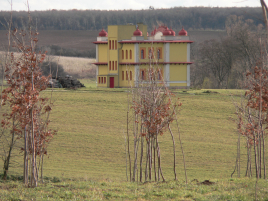New Vraja Dhama Plants Forests for Carbon-Neutral Heating
By Madhava Smullen | Мар 27, 2011

Devotees at New Vraja Dhama, a sustainable ISKCON farm community in Hungary also known as Krishna Valley, are set to plant 6.5 hectares of trees—an incredible 50,000 Acacias, Oaks, and Willows—on their property at the end of this March.
But the effort is just a fraction of a much bigger project that has been underway since the community’s inception in 1993.
“This will bring the amount of trees we’ve planted since starting our 660-acre farm to 54 hectares—or 133 acres,” says Radha Krishna Dasa, who moved to Krishna Valley nearly six years ago with his wife and mother. “We aim to plant 5 to 10 hectares of trees every year from now on, which will enable us to reach our goal of 100 hectares of permanent forest in 5 to 7 years,” he says.
There are two main reasons for this ambitious project.
The first is to supply New Vraja Dhama’s 150 devotees with one hundred per cent of the wood needed for their heating from their own forests. Currently, about thirty-five per cent comes from their forest while the rest is purchased outside. This is partly because not enough trees have been planted yet, and partly because it takes at least ten years for the two to four-year-old saplings the community plants to grow to the size where they can be cut for firewood.

“Planting our own forests and burning the wood gives us a carbon neutral heating source—in other words, it does not leave a carbon footprint on the planet,” says Radha Krishna Dasa. “Trees take in Carbon dioxide, or CO2, and nourish themselves with it through the process of photosynthesis—and our forests will consume exactly the same amount of CO2 in growing as we will put into the atmosphere by heating our homes.”
The second reason New Vraja Dhama devotees are planting trees is that it will enhance the habitat for animals and increase biodiversity in the area.
“Today, biodiversity around the world is decreasing at an alarming rate,” says Radha Krishna. “We are trying to do our small part to fight against that. When we bought our land, there were twenty-five to thirty different kinds of birds in the area. Now, after years of not using any chemicals, trying to preserve the countryside as it is, and planting trees common to the area, we have about 120 different types of birds.”

The devotees will also integrate the project into their community’s gurukula school education by installing fifty birdhouses in the trees. The school children will regularly check on the birds that visit them, and learn about the different species, how many of each kind there are, whether or not they are reproducing, and what their nesting habits are.
“We are also embarking on a larger project, in which we are researching the hundreds of acres of surrounding forests and finding 60 to 100-year-old abandoned fruit trees,” Radha Krishna says. “As well as taking care of them so that they continue to yield fruit, we are also working with local authorities and getting government funding to do gene-preservation.”
As usual, New Vraja Dhama continues to give an excellent example of the positive results we see when we try to take steps towards a more simple, natural way of life.
















